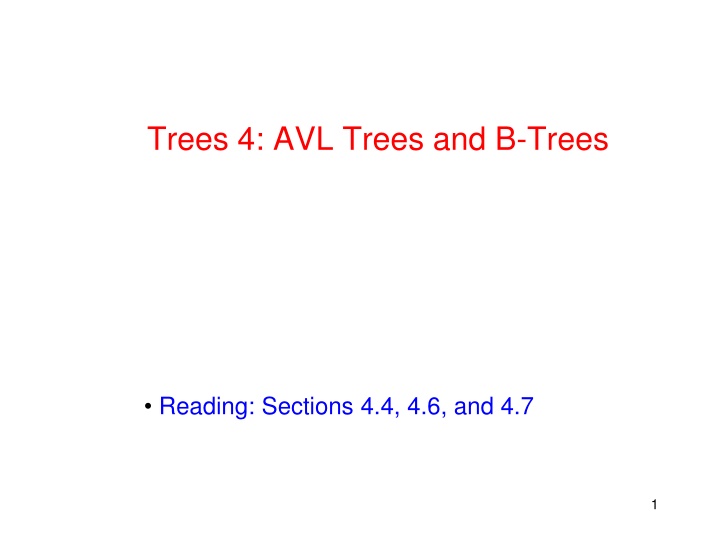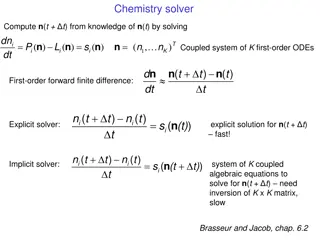
AVL Trees: Balance Conditions and Rotations
Discover the intricacies of AVL Trees, a type of binary search tree with a balance condition ensuring efficient search complexity. Explore how balance conditions are maintained through rotations and learn about the overhead and advantages of AVL Trees. Dive into cases of balance condition violations and understand the process of single and double rotations to rebalance AVL Trees. Witness examples of AVL Tree operations to deepen your understanding of these efficient data structures.
Download Presentation

Please find below an Image/Link to download the presentation.
The content on the website is provided AS IS for your information and personal use only. It may not be sold, licensed, or shared on other websites without obtaining consent from the author. If you encounter any issues during the download, it is possible that the publisher has removed the file from their server.
You are allowed to download the files provided on this website for personal or commercial use, subject to the condition that they are used lawfully. All files are the property of their respective owners.
The content on the website is provided AS IS for your information and personal use only. It may not be sold, licensed, or shared on other websites without obtaining consent from the author.
E N D
Presentation Transcript
Trees 4: AVL Trees and B-Trees Reading: Sections 4.4, 4.6, and 4.7 1
AVL (Adelson-Velskii and Landis) Trees AVL tree is binary search tree with balance condition To ensure depth of the tree is O(log(N)) And consequently, search complexity bound O(log(N)) Balance condition For every node in tree, height of left and right subtree can differ by at most 1 How to maintain balance condition? Rotate nodes if condition violated when inserting nodes Assuming lazy deletion 2
Balance Condition Violation If condition violated after a node insertion Which nodes we need to rotate? Only nodes on path from insertion point to root may have their balance altered If we rebalance tree at the deepest node along path The entire tree will be rebalanced Violation cases at node k (deepest node) 1. An insertion into left subtree of left child of k 2. An insertion into right subtree of left child of k 3. An insertion into left subtree of right child of k 4. An insertion into right subtree of right child of k Cases 1 and 4 equivalent Single rotation to rebalance Cases 2 and 3 equivalent Double rotation to rebalance 4
AVL Trees Overhead Extra space for maintaining height information at each node Insertion becomes more expensive Advantage All tree operations except insertion in O(log(N)) In particular, the search operation is O(log(N)) 5
Single Rotation (Case 1) Replace node k2 by node k1 Set node k2 to be right child of node k1 Set subtree Y to be left child of node k2 6
Example After inserting 6 Balance condition at node 8 is violated 7
Single Rotation (Case 4) Replace node k1 by node k2 Set node k1 to be left child of node k2 Set subtree Y to be right child of node k1 8
Example Inserting 3, 2, 1, and then 4 to 7 sequentially into empty AVL tree 3 2 2 3 1 1 9
Example (Contd) Inserting 4 2 3 1 4 Inserting 5 2 2 3 1 4 1 4 5 3 5 10
Example (Contd) Inserting 6 4 2 2 5 4 1 6 1 3 5 3 6 Inserting 7 4 4 2 6 2 5 7 1 3 5 6 1 3 7 11
Single Rotation not Work for Other Cases For case 2 After single rotation, k1 still not balanced Double rotations needed for case 2 and case 3 12
Double Rotation (Case 2) Left-right double rotation to fix case 2 First rotate between k1 and k2 Then rotate between k2 and k3 13
Double Rotation (Case 3) Right-left double rotation to fix case 3 First rotate between k2 and k3 Then rotate between k1 and k2 14
Example Continuing the previous example by inserting 16 down to 10, and then 8 and 9 Inserting 16 and 15 4 4 2 6 2 6 15 1 3 5 7 1 3 5 7 16 16 15 15
Example (Contd) Inserting 14 4 4 2 7 2 6 15 1 3 6 15 1 3 5 16 14 7 16 5 14 Other cases as exercises 16
Implementation of AVL Tree struct AvlNode { Comparable AvlNode AvlNode int element; *left; *right; height; AvlNode( const Comparable & ele, AvlNode *lt, AvlNode *rt, int h = 0 ) : element{ ele }, left{ lt }, right{ rt }, height{ h } { } AvlNode( Comparable && ele, AvlNode *lt, AvlNode *rt, int h = 0 ) : element{ std::move( ele ) }, left{ lt }, right{ rt }, height{ h } { } }; /** * Return the height of node t or -1 if nullptr. */ int height( AvlNode *t ) const { return t == nullptr ? -1 : t->height; } 17
Insertion into an AVL Tree /** * Internal method to insert into a subtree. * x is the item to insert. * t is the node that roots the subtree. * Set the new root of the subtree. */ void insert( const Comparable & x, AvlNode * & t ) { if( t == nullptr ) t = new AvlNode{ x, nullptr, nullptr }; else if( x < t->element ) insert( x, t->left ); else if( t->element < x ) insert( x, t->right ); balance( t ); } 18
Insertion into an AVL Tree (Contd) static const int ALLOWED_IMBALANCE = 1; // Assume t is balanced or within one of being balanced void balance( AvlNode * & t ) { if( t == nullptr ) return; if( height( t->left ) - height( t->right ) > ALLOWED_IMBALANCE ) if( height( t->left->left ) >= height( t->left->right ) ) rotateWithLeftChild( t ); else doubleWithLeftChild( t ); else if( height( t->right ) - height( t->left ) > ALLOWED_IMBALANCE ) if( height( t->right->right ) >= height( t->right->left ) ) rotateWithRightChild( t ); else doubleWithRightChild( t ); t->height = max( height( t->left ), height( t->right ) ) + 1; } Case 1 Case 2 Case 4 Case 3 19
B-Trees: Problem with Big `O notation Big O assumes that all operations take equal time Suppose all data does not fit in memory Then some part of data may be stored on hard disk. CPU speed is in millions of instructions per second 3GHz machines Equals roughly 3000 million instructions per seconds Typical disk speeds about 7,200 RPM Roughly 120 disk accesses per second So accessing disk is incredibly expensive. So we may be willing to do more computation to organize our data better and make fewer disk accesses. 22
Problem with binary trees There is no guarantee that binary trees will be balanced If stored on disk, we have potentially O(N) disk operations 23
M-ary Trees Allows up to M children for each node Instead of max two for binary trees A complete M-ary tree of N nodes has a depth of logMN Example of complete 5-ary tree of 31 nodes 24
M-ary search tree Similar to binary search tree, except that Each node has (M-1) keys to decide which of the M branches to follow. Larger M smaller tree depth But how to make M-ary tree balanced? 25
B-Tree (or Balanced Trees) B-Tree is an M-ary search tree with the following balancing restrictions 1. Data items are stored at the leaves 2. Non-leaf nodes store up to M-1 keys to guide the searching Key i represents the smallest key in subtree (i+1) 3. The root is either a leaf, or has between 2 to M children 4. All non-leaf nodes have between ceil(M/2) and M children 5. All leaves are at the same depth and have between ceil(L/2) and L data items, for some L. 26
B-Tree Example M=5, L=5 27
B-Tree: Inserting a value After insertion of 57. Simply rearrange data in the correct leaf. 28
B-Tree: Inserting a value (contd) Inserting 55. Splits a full leaf into two leaves. 29
B-Tree: Inserting a value (contd) Insertion of 40. Splits a leaf into two leaves. Also splits the parent node. 30
B-tree: Deletion of a value Deletion of 99 Causes combination of two leaves into one. Can recursively combine non-leaves 31
Questions How does the height of the tree grow? How does the height of the tree reduce? How else can we handle insertion, without splitting a node? 32
Reading Assignment Section 4.8 Chapter 5 33












